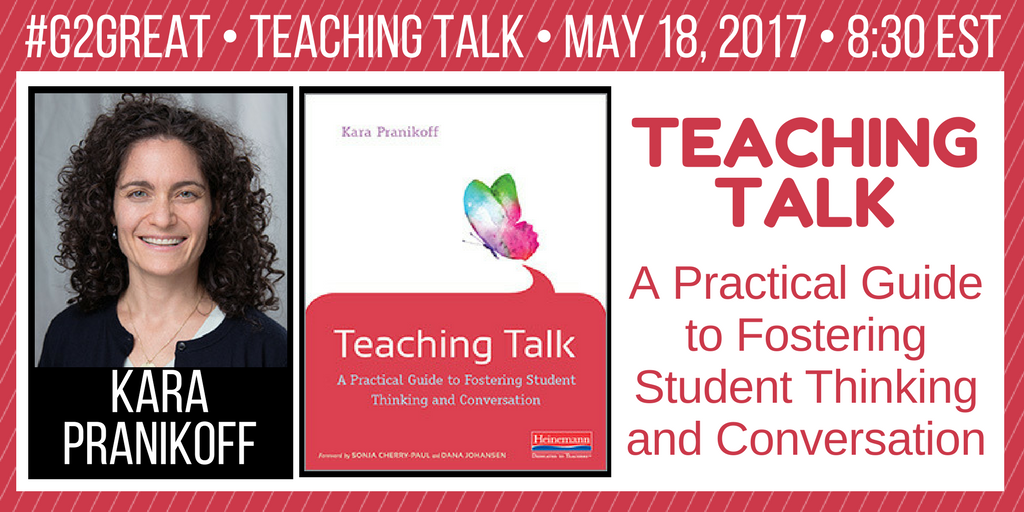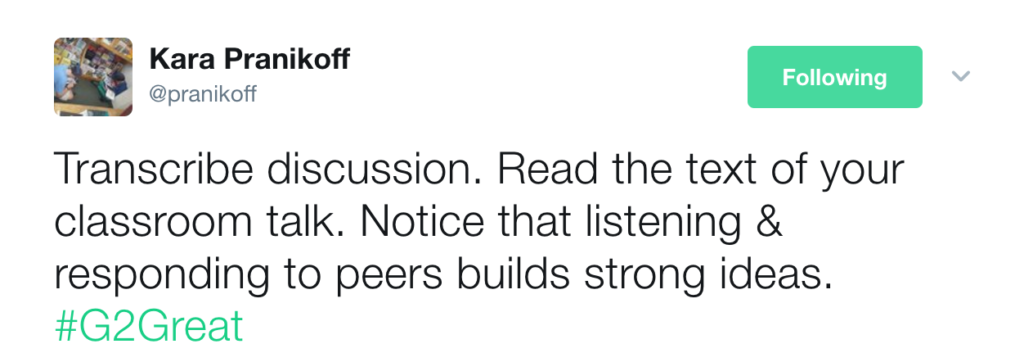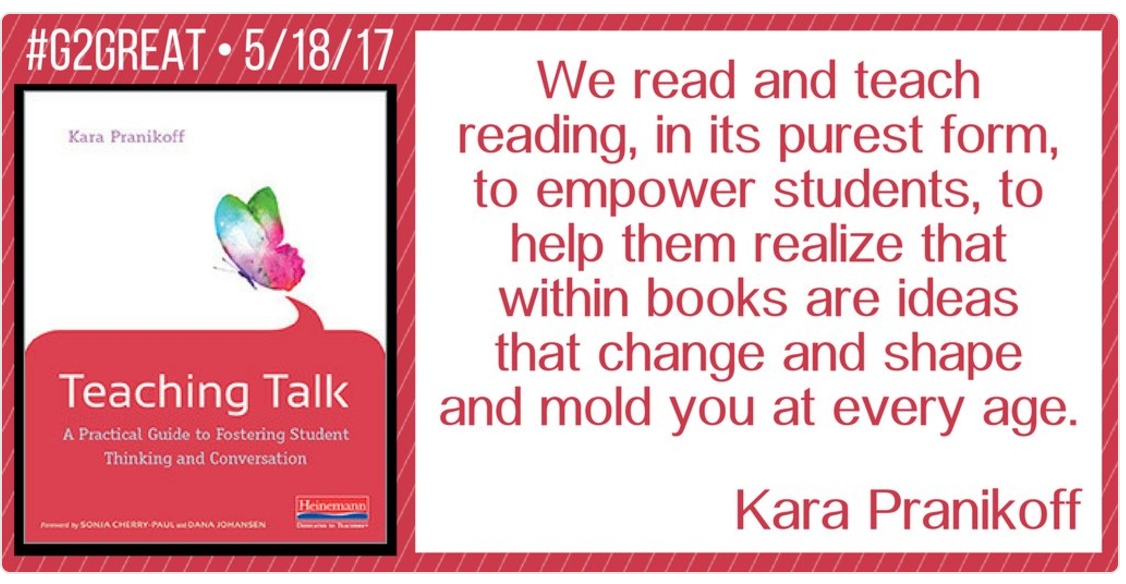By Jenn Hayhurst
I think by now everyone know members of #G2Great PLN like to talk. As a matter of fact, my good friend and mentor Dr Mary Howard just hit 50.5 K Tweets! To use Mary’s words, “What can I say, I like to talk.”
Teachers embrace talk because it is foundational for creating community. A good conversation grants us access to higher levels of understanding. On May 18, 2017 Kara Pranikoff hosted #G2Great to discuss her new book, Teaching Talk, A Practical Guide to Fostering Student Thinking and Conversation and we explored ways to leverage talk to develop greater sophistication for how to use talk to bolster thinking and learning in the classroom.
Bridging research to classroom practice is the heart of Mary’s book, Good To Great Teaching . When we say “yes” to research, the next thing to do is to make our classrooms home to action research. We are all approaching the end of a school year, and now is the perfect time to try out some of the practices we are learning about during our #G2Great chats so we can finish strong and use what we learn in the year ahead.
As I think about how I can strengthen my talk practices in my own teaching. These two tweets sparked my learning into action:
Jenny and Kara inspired me to think about and adjust my own practices. First I will more intentionally offer explicit models to increase student engagement within collaborative dialogue and second I will keep a concrete reference of that dialogue use as an instructional springboard to next steps. The following is a transcript of an exchange between a partnership. The transcript is from two students discussing the benefits of using Thinking Tracks. Thinking Tracks is a tool I created, after attending a Summer Reading Institute at the Reading and Writing Project. The intention for the tool is to help students annotate texts quickly.
London: “Well a thinking track is really like used to jot down something. Like if I say, in the book Shortcut, they’re on a train track. That’s surprising to me, so I’d like jot down a surprising mark.”
Daniela: “Yeah, like um I will use this the Thinking Track by surprising. When they were all like looking and listening to the sounds and looking they were all surprised. I was surprised too that the kids were there on the train tracks. It is dangerous because they hurried and looked at the train coming through. On the other side they thought a train wasn’t coming, but the train passed! Someone could have maybe got hurt.”
London: “It (this book) opens up with a big twist and we just started the book!”
Daniela: “These tracks, like funny, important favorite, and surprised, connecting, I wonder, and there is one more conforce, confus, confusing.” (laughing a little) “You can all use these even the little pictures that show us how to use them.”
London: “It’s just a quick jot.”
What did my transcriptions do for me as a professional willing to shift my stance as a learner?
It shows me that both students have a strong understanding for how to use the tool.
It shows me that Daniela is learning how to integrate academic talk into her conversational speech.
This conversation gives me some insights as to the kinds of language standards I might want to lean into.
I can see that multisyllabic words, even familiar ones, might be still challenging to read flexibility.
I can use this conversation as mentor text to teach other students how to use the tool in a number of ways!
I can read it aloud to the rest of the class, or even next year’s class to demonstrate the value of the tool by pairing that with a copy of Donal Crew’s Shortcuts.
I can leave a copy of the transcript for students to read and annotate in a write around.
Just the act of transcribing their conversation sends a strong message to my students, we value talk here. It elevates their conversations to a new level of importance. They begin to see each other as a source of information to learn from. Wow!
I am grateful that Kara has elevated my own thinking about talk and I am going to use these points and her phenomenal book to fine tune my thinking this summer. Yes, this just the beginning of my learning and I invite you to join me so we can all delve deeper into her remarkable thinking. If you are reading this blog, you are the kind of teacher who is on a constant journey to bring your good classroom practices to great ones. It is every author’s hope that their work will inspire ours. When we read a professional book we are entering into a partnership that aspires to empower learning and benefit the intellectual world that we create for our students. We are co-creating a better opportunities for ourselves and our students. Happy reading.
LINKS
Teaching Talk: A Practical Guide to Fostering Student Thinking & Conversation
http://www.heinemann.com/products/E08676.aspx
Breathing New Life Into the Talk in Your Classroom
http://www.heinemann.com/blog/breathing-new-life-into-the-talk-in-your-classroom/



